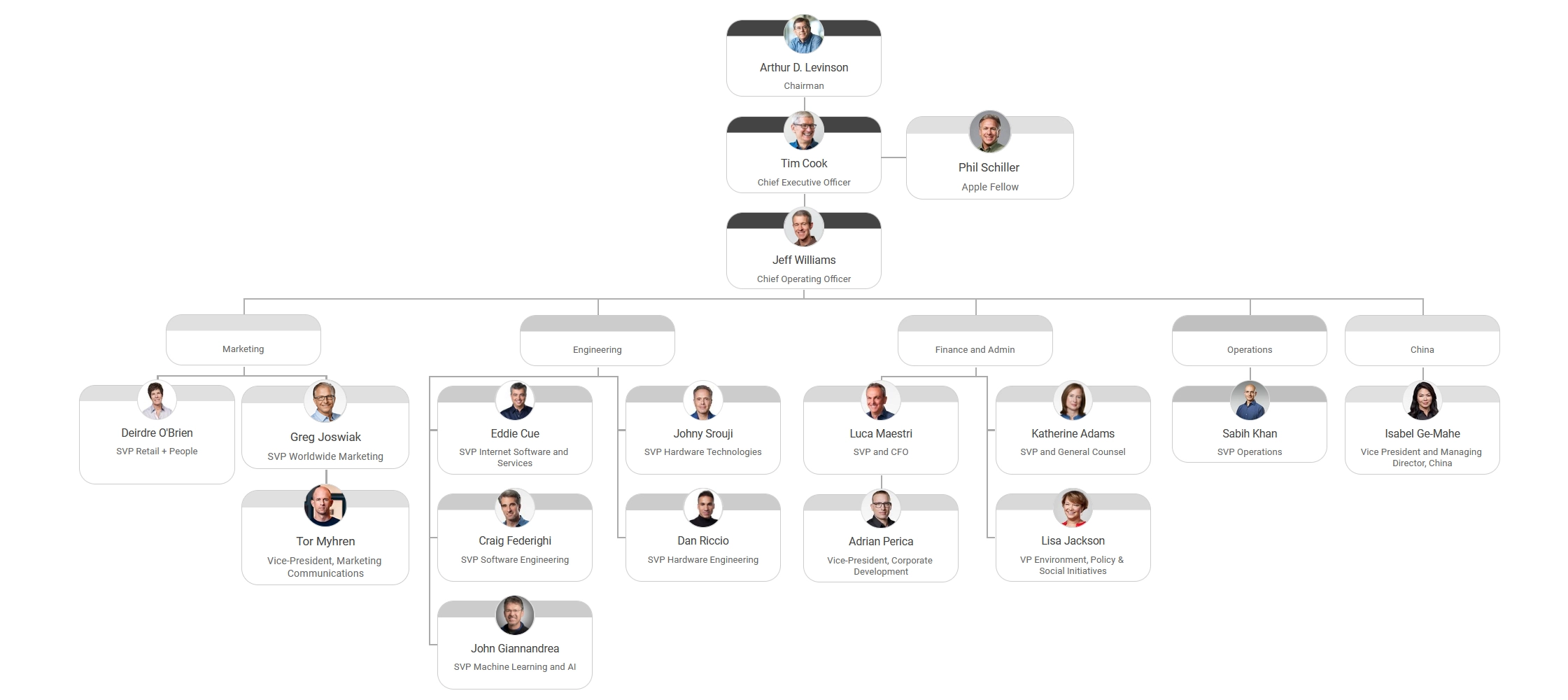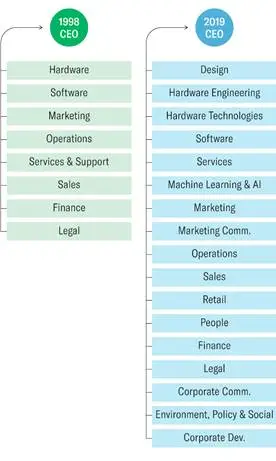Organizational Structure of Apple
Published May 13, 2020 | Author: PenMyPaperKey Points
- Apple follows a well-defined vertical hierarchical structure.
- This structure allows the higher management to have tight control over every operational activity.
- The company has further segregated its business based on its sources of revenue and geographic regions.

The organizational structure of Apple has undergone a drastic change in the year 1997, when Steve Jobs returned to his position as the CEO. Previously, the company followed a very conventional structure, where the company was divided into its business units and each one of those business units had their own financial responsibilities. However, following the return of Steve Jobs, the company, under his supervision, was restructured to have the entire company under one financial umbrella and combined the disparate departments of the various business units under one functional organization that aligns expertise with decision rights. This structure is retained till today.In this article, our paper writer will explore the organizational structure of Apple in depth.
Organizational Structure of Apple
The organizational structure of Apple is a combination of hierarchical and functional structures. This has enabled the higher management to have complete and close control over every activity within the firm.
The Hierarchical Structure
Apple follows a well-defined vertical structure, where the CEO of the company is directly reported by the senior vice presidents, chief design officer, chief operating officer and the vice presidents. The senior vice presidents look after the departments such as retail, software engineering, worldwide marketing, hardware technologies, etc. Likewise, the vice presidents look after the departments like communications, user interface design, human resources, environmental policies and initiatives, etc. The key advantage of this hierarchical structure is that the company has tight control over its operational activities and every functional unit is closely adhered to the well-defined organizational culture and regulations.
Over the years, the company has expanded significantly, resulting in a drastic increase in the number of functional units. However, even with its present behemoth stature, the hierarchical structure is still maintained. The retention of this hierarchical structure is a clear sign that Apple is quite strict with its policies and prefers to maintain a closed environment.
Also read about the Apple Competitors in case you are trying to gain a better understanding of the competitive landscape and technological dynamics within the industry.
The Functional Structure
The functional structure of Apple segregates the company based on its sources of revenue, which are its products and services. According to the annual report of the company has been segregated into the following segments:
- iPhone
- Mac
- iPad
- Wearables, Home and Accessories
- Services
The iPhone segment includes the smartphones running on their proprietary iOS operating system. The Mac includes all the Macintosh computers, including the laptops and desktops and mini computers. The iPad section includes the tablet computers such as the iPad, iPad Air, iPad Pro, etc., running on iPad OS. The wearables, home and accessories, includes the Apple Watch, Homepod, Apple TV, and other accessories. Finally, the services section includes the subscription-based services, such as Apple Music, Apple TV+, Apple Arcade, etc.
Even though the functional segmentation has segregated the business based on different product categories, these products are closely linked together to provide the users with a unified experience. Each of these above-mentioned segments work closely together to offer the customers a wholesome experience of using multiple Apple products together.
It should be noted that each of these product categories are not overseen by individual vice presidents. Instead, the vice presidents of different departments oversee various product categories. To put it simply, the senior vice president of software engineering, Craig Federighi looks after the software development of all Apple products. Likewise, the SVP of hardware engineering, John Ternus looks after the hardware development of all product categories.
You may also like to go through the Apple vision statement.
Geographic Segmentation
Apple is a globally operational company, which sells its products in multiple regions. In order to have better control and vision over its international business ventures, the company has decided to segregate the operations based on different geographic regions. These segments are:
- Americas
- Europe
- Greater China
- Japan
- Rest of Asia Pacific
Americas has by far recorded the highest sales volume, followed by Europe and Greater China.
Check out our comprehensive article on Apple's Competitive Advantages to delve deeper into the core strengths that have propelled the company to its iconic status in the tech world.
Apple Leadership Structure
The hierarchical and functional structure of Apple is clearly reflected in the current leadership structure.
The Tim Cook reports to the Chairman of the Board, Arthur D. Levinson. Cook is reported by the Chief Operating Officer, who in turn is reported by different vice presidents overlooking various functional departments. A detailed structure of Apple’s leadership is shown in the figure below.

Hopefully, this article has given you a better understanding of the apple organizational structure. In case you are struggling with any of your project, you have the option to buy essay online. PenMyPaper is your go-to destination for academic help that guarantees impeccable quality and timely delivery.


